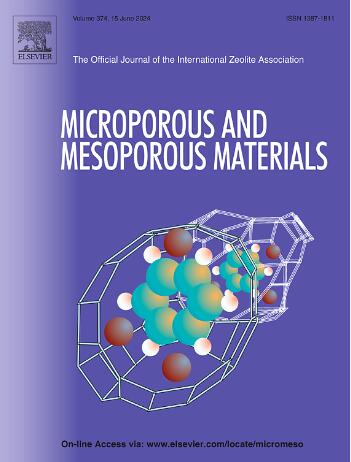Nanoscale structure of ordered mesoporous carbon formed by nanocasting within a hard template: MD simulation with ML potentials
IF 4.7
3区 材料科学
Q1 CHEMISTRY, APPLIED
引用次数: 0
Abstract
Molecular Dynamics simulations with machine learned (ML) potentials are utilized to develop models for the structure of ordered mesoporous carbons (OMC) formed by nanocasting in hard templates with linear cylindrical pores, e.g., SBA-15. Potentials are initially trained on PBE DFT, but subsequently enhanced by transfer-learning to suitably incorporate vdW energetics. Rather than analyze the larger-scale mesoporous structure, we focus on the disordered partially graphitized structure of a carbon nanorod formed within a single pore of the template. In benchmark simulations, carbon is confined to a cylindrical pore by surrounding inert immobile atoms, and in more realistic simulations by utilizing an atomistic model for amorphous mesoporous silica. We assess the dependence of OMC structure on the description of the hard template, and on the selection of the carbon precursor. Depending on the template materials and synthesis conditions, structures ranging from multi-wall carbon nanotubes or nanoscrolls to more disordered and complex structures involving carbon nanoribbon and nanodisc motifs, are found in simulations with the more realistic templates. At lower temperatures, where dehydrogenation processes occur at a similar or slower time scale than the growth of the carbon material, the choice of carbon feedstocks also affects the structures of the synthesized OMC.

硬模板内纳米铸造形成有序介孔碳的纳米级结构:具有ML电位的MD模拟
利用机器学习(ML)势的分子动力学模拟来开发有序介孔碳(OMC)的结构模型,OMC是通过纳米铸造在具有线性圆柱形孔的硬模板中形成的,例如SBA-15。电位最初是在PBE DFT上训练的,但随后通过迁移学习来增强,以适当地结合vdW能量学。而不是分析更大规模的介孔结构,我们关注的是碳纳米棒在模板的单个孔内形成的无序部分石墨化结构。在基准模拟中,碳被周围的惰性不动原子限制在圆柱形孔中,而在更现实的模拟中,利用非晶介孔二氧化硅的原子模型。我们评估了OMC结构对硬模板描述和碳前驱体选择的依赖性。根据模板材料和合成条件的不同,在模拟中可以发现从多壁碳纳米管或纳米卷到包含碳纳米带和纳米盘基序的更无序和复杂的结构。在较低温度下,脱氢过程发生的时间尺度与碳材料的生长相似或更慢,碳原料的选择也会影响合成的OMC的结构。
本文章由计算机程序翻译,如有差异,请以英文原文为准。
求助全文
约1分钟内获得全文
求助全文
来源期刊

Microporous and Mesoporous Materials
化学-材料科学:综合
CiteScore
10.70
自引率
5.80%
发文量
649
审稿时长
26 days
期刊介绍:
Microporous and Mesoporous Materials covers novel and significant aspects of porous solids classified as either microporous (pore size up to 2 nm) or mesoporous (pore size 2 to 50 nm). The porosity should have a specific impact on the material properties or application. Typical examples are zeolites and zeolite-like materials, pillared materials, clathrasils and clathrates, carbon molecular sieves, ordered mesoporous materials, organic/inorganic porous hybrid materials, or porous metal oxides. Both natural and synthetic porous materials are within the scope of the journal.
Topics which are particularly of interest include:
All aspects of natural microporous and mesoporous solids
The synthesis of crystalline or amorphous porous materials
The physico-chemical characterization of microporous and mesoporous solids, especially spectroscopic and microscopic
The modification of microporous and mesoporous solids, for example by ion exchange or solid-state reactions
All topics related to diffusion of mobile species in the pores of microporous and mesoporous materials
Adsorption (and other separation techniques) using microporous or mesoporous adsorbents
Catalysis by microporous and mesoporous materials
Host/guest interactions
Theoretical chemistry and modelling of host/guest interactions
All topics related to the application of microporous and mesoporous materials in industrial catalysis, separation technology, environmental protection, electrochemistry, membranes, sensors, optical devices, etc.
 求助内容:
求助内容: 应助结果提醒方式:
应助结果提醒方式:


